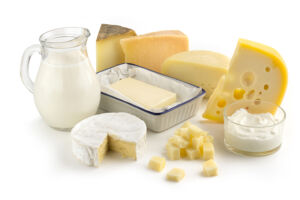Foods & Ingredients to Avoid with a Milk Allergy
There are two primary proteins that can cause an allergic reaction: casein and whey. Casein is found in the solid part of milk that curdles, while whey is found in the liquid. Those who suffer from a dairy allergy may either have a casein allergy, a whey allergy, or both.
Not surprisingly, both casein and whey are found in a vast variety of dairy products. And while milk allergy is typically linked to cow’s milk, adverse reactions can also stem from goat, buffalo, or sheep’s milk. Examples of common foods to avoid include:
-
- Cheese
- Cottage cheese
- Custard
- Cream
- Buttermilk
- Pudding
- Sour cream
- Yogurt
- Milk in all forms (including powdered milk and evaporated milk)

Products that contain milk ingredients and protein can also trigger an allergic reaction, such as foods that are made with dairy, whey, lactose, and casein. Those with a dairy allergy should stay away from these allergy-triggering ingredients:
-
- Butter, butter fat, butter oil, butter acid, butter ester(s)
- Diacetyl (often found in butter flavoring)
- Rennet casein (milk protein often used in processed cheese or deli meats)
- Tagatose (often used as an artificial sweetener)
- All forms of whey (concentrate, isolate, and hydrolysate)
- Any artificial butter or cheese flavoring
Milk proteins and by-products are present in far more than dairy products, which can make it challenging to avoid allergic triggers. Check the label on salad dressings, baked goods, cereals, donuts, cake mixes, and any canned or processed meats to ensure there are no harmful ingredients.
How is Milk Allergy Treated at Latitude Food Allergy Care?
Milk Allergy Treatment with Oral Immunotherapy
Persistent milk allergy can be treated with oral immunotherapy (OIT) in patients of all ages. Historically patients with milk allergies have been guided to avoid all dairy products. Unfortunately, avoidance is not easy nor is it foolproof. Luckily, avoidance is no longer the only answer.
Latitude’s evidence-based program is built on clinical studies and protocols from leading research institutions, including Stanford, Duke, and Baylor. Our clinical partnerships with UCSF and Weill-Cornell ensure that we continue to provide the highest level of specialized food allergy care. In fact, 92% of Latitude OIT patients successfully reach maintenance and are desensitized to their allergens.
Effectiveness of Oral Immunotherapy in Milk Allergy Treatment
Research has demonstrated that OIT is safe and effective in minimizing reactions to unsuspected contact with food allergens. A 2016 study, one of many to arrive at the same conclusion, showed that adverse reactions were markedly reduced in patients who underwent OIT to cow’s milk, significantly improving their safety and quality of life.
Oral immunotherapy gradually exposes the patient to small doses of an allergen over time. This desensitizes the body and helps to retrain the immune system, decreasing adverse allergic reactions. At Latitude Food Allergy Care, oral immunotherapy is offered for multiple allergens with or without Xolair: an anti-IgE monoclonal antibody that helps suppress allergic reactions.
Oral immunotherapy can be an effective milk allergy treatment, whether the patient has a casein allergy, whey allergy, or both.
For many, oral immunotherapy also creates dramatic improvements in overall quality of life, providing a safeguard against reactions to accidental exposures and empowering them with greater dietary flexibility. At Latitude, 92% of OIT patients are successfully desensitized to their allergens.
Is OIT Safe for Treating Milk Allergies?
Yes. OIT may sound scary, particularly for patients who have experienced severe allergic reactions. However, when conducted under the guidance of a trained clinician, OIT is safe and effective in treating food allergies
Can a Milk Allergy Be Cured?
There is no guaranteed cure for milk allergies, but there are methods you can follow to provide safety and treatments that can reduce your risk. First, be aware of the ingredients that could trigger a milk allergy reaction. Milk allergy testing including oral food challenges can provide clarity on your specific triggers.
Avoidance isn’t the only answer, though. Oral immunotherapy is an effective treatment for milk allergies, and can provide protection against accidental exposures. Talk with your doctor to understand what options are available to help you live more freely.

